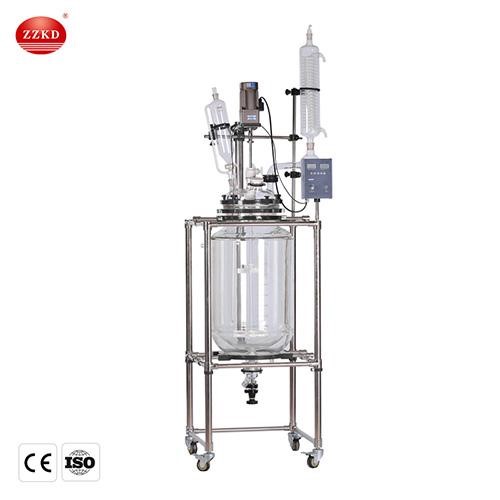A 5L glass reactor can be used for extraction processes, such as solvent extraction or liquid-liquid extraction, to separate desired compounds from a mixture. Here is a general overview of how to use a glass reactor for extraction:
Set up the Glass Reactor: Ensure that the 5L glass reactor is properly assembled and clean. Check all the connections, seals, and ports to ensure they are secure and leak-free. Make sure the reactor vessel is appropriately sized for the desired extraction volume.
Prepare the Mixture: Prepare the mixture that needs to be extracted. This can involve combining the source material or sample with the appropriate solvent or extraction medium. The selection of the solvent will depend on the compounds of interest and their solubility properties.
Load the Mixture into the Reactor Vessel: Carefully pour the mixture into the glass reactor vessel, ensuring that the vessel is not overfilled to allow for adequate mixing and agitation.
Set the Extraction Conditions: Determine the appropriate extraction conditions, such as temperature, stirring speed, and extraction time. These conditions will vary depending on the specific extraction process and the compounds being targeted. Ensure that the temperature and stirring speed are within the safe operating range of the glass reactor.
Initiate the Extraction: Start the stirring mechanism in the glass reactor to initiate the extraction process. The stirring helps to enhance the contact between the solvent and the compounds to facilitate efficient extraction. Adjust the stirring speed as needed to achieve the desired mixing and extraction efficiency.
Monitor the Extraction Process: Monitor the extraction process by sampling the mixture at various time intervals. Withdraw a small volume of the mixture using the appropriate ports or sampling accessories without interrupting the extraction process. Analyze the samples using suitable techniques to assess the progress of the extraction and determine when the desired compounds have been adequately extracted.
Terminate the Extraction: Once the desired extraction level is reached, stop the stirring and separate the extracted solution from the residual mixture. This can be done by draining the liquid phase through the appropriate outlet or by using filtration or separation techniques.
Recovery and Purification: After the extraction, the extracted solution can undergo further purification or concentration steps to isolate the desired compounds. This may involve techniques such as evaporation, filtration, chromatography, or crystallization.
Cleaning and Maintenance: After completing the extraction process, clean the glass reactor thoroughly to remove any residues or contaminants. Follow proper cleaning procedures and protocols to ensure the reactor is ready for subsequent use.
Safety Considerations: Ensure that you follow appropriate safety protocols when working with extraction processes. This includes working in a well-ventilated area, wearing appropriate personal protective equipment (PPE), and handling any potentially hazardous materials or solvents with care.
Solvent Selection: Choose the solvent carefully based on the solubility of the compounds you wish to extract. Consider factors such as polarity, selectivity, toxicity, and environmental impact when selecting a solvent. It is also important to ensure that the solvent is compatible with the glass reactor material to avoid any corrosion or damage.
Scale-Up Considerations: If you plan to scale up the extraction process from laboratory-scale to larger volumes, it is important to consider the limitations of the glass reactor. Glass reactors are typically limited in size due to their mechanical strength. For larger-scale extractions, alternative equipment such as stainless steel reactors or extraction columns may be more suitable.
Optimization and Parameters: The efficiency of the extraction process can be influenced by various parameters, including temperature, agitation speed, extraction time, solvent-to-sample ratio, and particle size. It is advisable to perform optimization experiments to determine the optimal conditions for your specific extraction process.
Multiple Extractions: In some cases, multiple extraction cycles may be required to increase the extraction efficiency. This involves repeating the extraction process with fresh solvent on the remaining residue to further extract the desired compounds.
Post-Extraction Analysis: After the extraction process, it is important to analyze the extracted solution to determine the concentration and purity of the desired compounds. Various analytical techniques, such as chromatography, spectroscopy, or titration, can be used for this purpose.
Record Keeping: Maintain detailed records of the extraction process, including the experimental conditions, parameters, and results. This documentation is important for reproducibility, troubleshooting, and future reference.
Process Optimization: Once you have established a baseline extraction procedure, you can further optimize the process by modifying parameters, exploring different solvents or extraction techniques, or incorporating additional purification steps.
Compliance and Regulations: Ensure that you comply with any applicable regulations, permits, or guidelines related to the extraction of specific compounds or handling of certain solvents. It is important to be aware of any legal restrictions or safety considerations associated with your extraction process.
It’s important to note that the specific extraction procedure and parameters will vary depending on the nature of the compounds being extracted and the desired extraction efficiency. It is advisable to consult relevant literature, protocols, or experts in the specific field to optimize the extraction process using a glass reactor.
